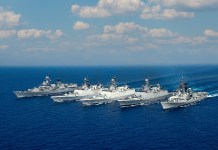The global appeal of the C-130J Super Hercules aircraft continues to grow, with Egypt becoming the latest country to incorporate this highly capable tactical airlifter in its fleet.
On September 5, the Egyptian Armed Forces announced that the Egyptian Air Force (EAF) would procure its first two C-130J-30 Super Hercules aircraft from Lockheed Martin. This announcement was made during the Egypt International Airshow, held in El Alamein from September 2 to 5.
Egypt is now the 23rd nation to join the global Super Hercules community, adding to the list of countries that rely on this proven airlifter.
The deal was facilitated through the US Foreign Military Sales (FMS) program, marking another significant step in Egypt’s modernization of its military capabilities.
The US Department of State had first approved the sale of 12 C-130J-30 aircraft to Egypt in January 2022, with an estimated value of $2.2 billion.
Tim German, Director, Capture Management at Lockheed Martin’s Aeronautics division, said that the company expects Egypt to receive an additional 10 aircraft, though this will be part of a staggered order.
While Lockheed Martin has not confirmed the delivery schedule, reports suggest that the first two aircraft will be delivered by 2026.
The C-130J-30 is known for its versatility and is expected to significantly enhance Egypt’s operational capabilities.

The US Defense Security Cooperation Agency (DSCA) highlighted that the aircraft will support Egypt’s border security, rapid response to internal threats, and humanitarian aid efforts. The EAF is also expected to use these aircraft for maritime patrols and search-and-rescue missions.
Egypt already operates a fleet of older C-130s, which includes 22 C-130Hs, three C-130H-30s, and two EC-130H Hercules models, according to Janes.
The acquisition of the C-130J-30s represents a strategic upgrade, enabling Egypt to perform a range of missions more effectively, from transporting equipment and personnel to delivering humanitarian relief.
Lockheed Martin has noted Egypt’s role as a key operator of the C-130 fleet in the Middle East and North Africa (MENA) region. With this procurement, Egypt joins seven MENA operators that favor the C-130J for medium-sized tactical airlift and tanker missions.
IAF’s C-130J Night Landing At Kargil Airstrip
The C-130J Super Hercules is a versatile aircraft that combines advanced aerospace technology with a rugged design to deliver exceptional operational efficiency.
It has become a critical asset for military operations worldwide because it can perform a wide range of missions, including cargo transport, special operations, aerial refueling, and search and rescue.
With a payload range exceeding 4,000 nautical miles and the ability to land on short dirt strips in challenging conditions, the C-130J is known for its reliability, particularly in high-altitude, hot environments.
Earlier this year, the Indian Air Force (IAF) demonstrated the C-130J’s reliability during a historic night landing at the Advanced Landing Ground in Kargil, near the Line of Control (LoC) with Pakistan.
The operation demonstrated the IAF’s capability to execute complex missions using terrain masking and advanced tactics.

The successful night landing was significant due to Kargil’s strategic location. It serves as a critical link between Ladakh and mainland India. Kargil has long been a vital logistical hub, especially for supporting Indian Army operations in Siachen.
Historically, the Zoji-La Pass, linking Kargil to the rest of India, was impossible for six months each year due to significant snowfall, making an advance stocking for winter months necessary for soldiers stationed in Siachen.
Over the years, the IAF has steadily improved the infrastructure at forward air bases like Thoise, Nyoma, and Daulat Beg Oldie (DBO), ensuring continuous air support.
The Kargil airstrip, located close to the Line of Control and within Pakistan’s artillery range, presents significant operational challenges. The short runway and high altitude make landings difficult, compounded by reduced engine efficiency and limited maneuvering space due to the surrounding mountains.
When military operations commenced during the Kargil conflict in 1999, the Indian Air Force (IAF) took full control of the Kargil airport from the Airports Authority of India (AAI). Due to its proximity to the Line of Control (LoC), the Kargil airfield was used mainly for helicopter operations.
Although the IAF deployed its AN-32 fixed-wing transport aircraft during the conflict, their operations were restricted to daylight hours.
In 2014, the IAF began upgrading the Kargil airfield’s infrastructure, including extending the runway to 9,000 feet, to accommodate larger aircraft like the C-17 Globemaster and C-130 J Super Hercules.
Despite these improvements, landing at Kargil remains challenging due to the short runway and the high altitude. Overshoots or “go-arounds” (a flight procedure in which an arriving aircraft aborts its landing procedure and returns to the landing queue) are extremely difficult. Therefore, the recent night landing of the C-130J at Kargil marked a major milestone for the IAF.
The aircraft’s advanced systems, including Night Vision Goggles (NVGs) and infrared thermal imagery, allowed pilots to safely navigate the rugged terrain and land in low-visibility conditions.
The mission’s success also sent a clear message to regional adversaries, particularly Pakistan and China, demonstrating India’s determination and ability to defend its borders.
The night landing at Kargil not only highlights the capabilities of the C-130J but also showcases the skill and professionalism of IAF pilots in executing complex operations under challenging conditions.
- Contact the author at ashishmichel(at)gmail.com
- Follow EurAsian Times on Google News




